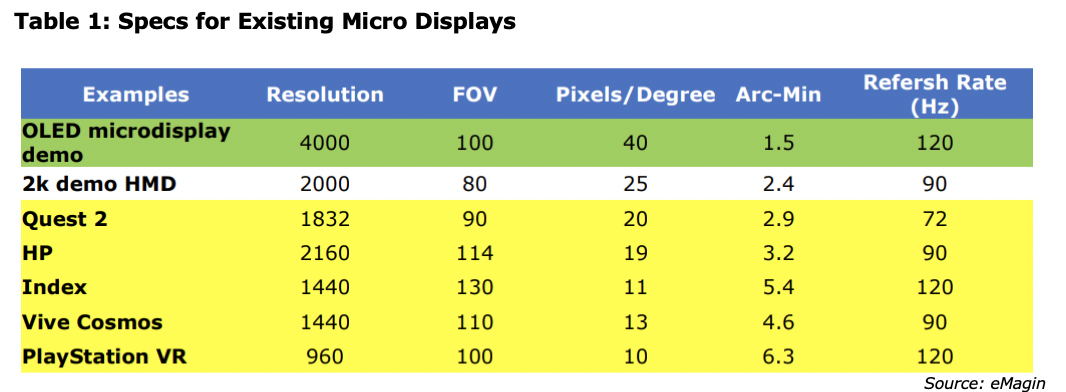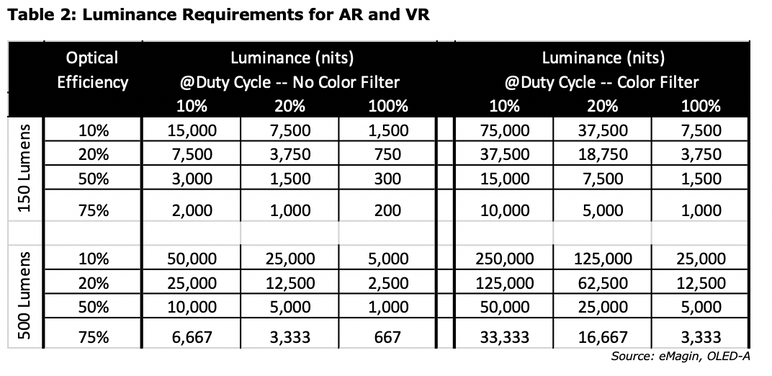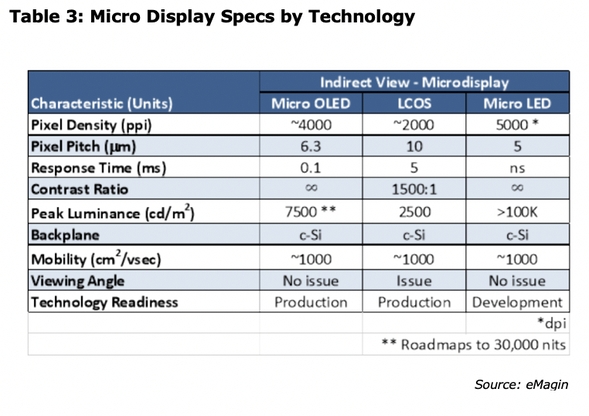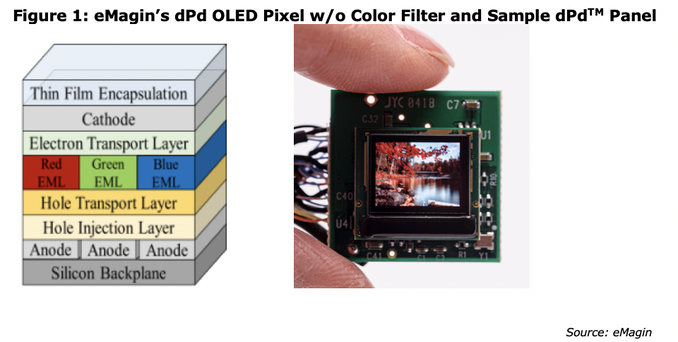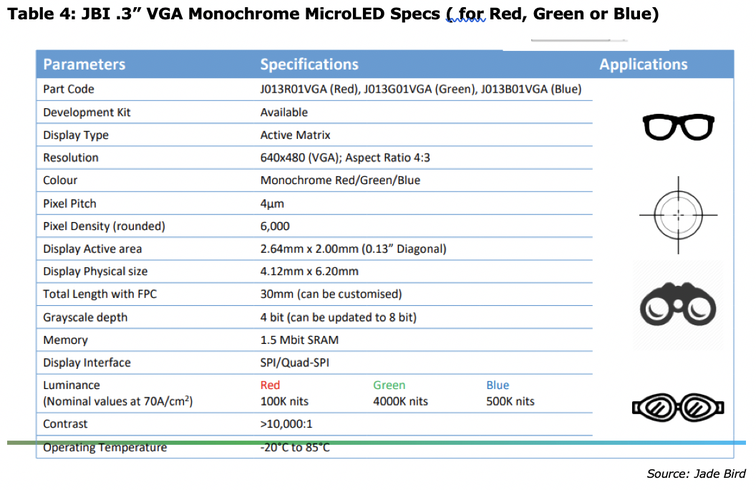Vertical Divider
AR Display Luminance Requirements: Micro OLEDs vs. Micro LEDs
eMagin COO Amal Ghosh (and former SID President) presented at the DisplayWeek’ symposium providing an update on the status and requirements for AR displays. Of particular note is that despite wild speculation, the # of AR devices shipped in 2020 was ~100k. IDC forecasts a volume of 24m by 2024 together with 20m VR headsets.
The challenge for micro displays is to contemporaneously produce luminance in the range of 30,000 to 50,000 nits, a duty cycle of 10%, an FOV of 1200 a resolution of 4,000 ppi and a foveated rendering capability. Amal derived these figure of merits based on the following requirements.
Since the human eye can resolve 60 pixels/degree, a resolution of 4kx4K is required to deliver a 1200 FOV. 60*120 = 7200 pixels (~4K). The next table lists some existing products. None meet the angular vision requirements
eMagin COO Amal Ghosh (and former SID President) presented at the DisplayWeek’ symposium providing an update on the status and requirements for AR displays. Of particular note is that despite wild speculation, the # of AR devices shipped in 2020 was ~100k. IDC forecasts a volume of 24m by 2024 together with 20m VR headsets.
The challenge for micro displays is to contemporaneously produce luminance in the range of 30,000 to 50,000 nits, a duty cycle of 10%, an FOV of 1200 a resolution of 4,000 ppi and a foveated rendering capability. Amal derived these figure of merits based on the following requirements.
- 1200 FOV – comes from the headset manufacturers
- 4,000 ppi – what eMagin believes is required to eliminate the screen door effect for near eye applications.
- 150 to 500 nits to the eye depending on the ambient lighting conditions.
- 10% duty cycle (persistence) – headset manufacturer’s requirement to reduce motion artifacts as the head turns
Since the human eye can resolve 60 pixels/degree, a resolution of 4kx4K is required to deliver a 1200 FOV. 60*120 = 7200 pixels (~4K). The next table lists some existing products. None meet the angular vision requirements
The luminance requirement is a function of the amount of light the eye can process. In a dark environment, it is 150 nits, for example VR. But the display must generate sufficient luminance to overcome, the light loss thru the lens, the persistence adjustment and the loss through a color filter, which is ~80% for white. The 80% light loss (20% efficiency) from color filters applies only to white light. The VR requirement for optical efficiency is ~20%, but for AR it is 10%. The difference is in the lens thickness. The thinner the lens the lower the efficiency and AR glasses require the slimmest form factor. For VR the luminance requirement is ~4,000 nits w/o a color filter and 8,000 nits with a color filter. For AR at 500 nits to the eye, the luminance is 50,000 w/o color filter and ~100,000 with a color filter according to eMagin as shown in the next table.
Ghosh then showed the current state of the art for indirect view micro displays by technology. While LCOS can be used for VR, it is a non-starter for AR. Examining the table, the primary performance differentiators between OLEDs and μLEDs are resolution and peak luminance.
The state of the art for OLED pixel density is 4000 ppi with a peak luminance of 7,500 nits. eMagin’s target is 30,000 nits, close but not 50,000 nits, which would then require some combination of a thicker lens and/or a higher duty cycle to meet the luminance requirement. A Jade Bird Display presentation at the Business Conference showed their μLED VGA blue panel with 6000 dpi (monochrome) producing 500K nits at 100% duty cycle, which if used for a full color display, w/color filter a 10% efficiency lens and a resolution of ~320 x 240 using a quad pixel would deliver 1715 nits to the eye. The calculation assumes 70% color down conversion efficiency from blue to red/green and 70% color filter efficiency. The light loss is 49%. Power consumption is based on current density of 70A/cm2 for Jade Bird’s μLEDs. Typical 3V operation leads to power consumption of 210W/cm2, which amounts to a total power consumption in Jade Bird’s monochrome VGA display of 11W. eMagin’s OLED at 7,500 nits is <1W.
eMagin uses a side-by-side RGB pixel format as shown in the next figure, which obviates the need for a color filter.
eMagin uses a side-by-side RGB pixel format as shown in the next figure, which obviates the need for a color filter.
The following specification was used in calculating the performance of μLEDs, it was presented by Jade Bird Display at DisplayWeek. The following specification was used in calculating the performance of μLEDs, it was presented by Jade Bird Display at DisplayWeek. Micro s displays using μLEDs use the full panel and do not need to transport the LEDs to a separate substrate. Jade Bird is working with Kopin to use their p-Si backplane.
|
Contact Us
|
Barry Young
|

